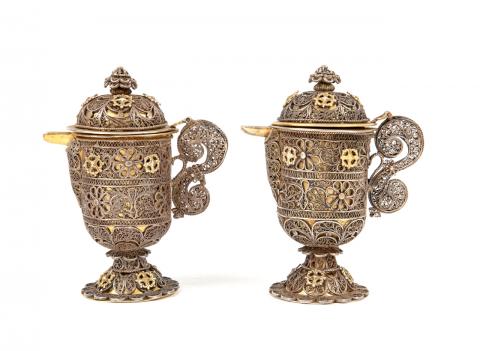Galhetas Litúrgicas
Altar Cruets
The Philippines; 17th century
Silver and gilt silver
Dim: 13.9 x 11.0 x 6.6 cm
Filipinas, século XVII
Prata e prata dourada
Dim: 13,9 x 11,0 x 6,6 cm
The present parcel-gilt silver and silver filigree altar cruets were conceived for using in Christian liturgical ceremonies, and produced in pairs, one destined to hold holy water and the other wine. Both feature unidentified and part worn hallmarks.
Characterised by rosette shaped stands and hemispherical feet fixed to the body by wire thread, the vessels are cylindrical, and rounded in their lower sections, and exhibit protruding spouts, S shaped handles and hinged covers of stepped flower shaped pommels and cast openwork thumbpieces.
Of double walls, the cruets have a plain double-faced gilt silver inner lining and an outer silver filigree openwork structure of flattened twisted thread, featuring horizontal bands of large, eight petalled rosettes, and narrow serpentine friezes, as well as other floral elements, to the feet, spouts, covers and handles. Cast and gilt silver quatrefoils, fixed to the white silver structure, decorate both cruets’ feet, bodies and covers.
The size of such liturgical vessels reflects the small quantity of wine they were destined to hold, most probably in a wealthy merchant or aristocratic private chapel context. Manufactured in Asia for exporting to Europe, their shape seems to derive from widely circulated, and lower priced, pewter made prototypes. A pair of identically shaped pewter cruets, made in the Netherlands during the early 18th century, belongs to the Victoria & Albert Museum collection, in London (M.548-1926). Another pair of closely related containers, but with their original stand, is recorded in a private collection. Unlike the present pair, they feature filigree ‘V’ and ‘A’ initials, for vinum and aqua, Latin terms for wine and water, surmounting the respective thumbpieces.
Following earlier and more traditional approaches regarding Asian filigree production centres in the Modern Era, our pair of cruets has been published as being made in Portuguese ruled Goa . Subsequent documental and archaeological research suggests The Philippines as the likely origin for these containers, as well as for other objects of identical filigree, shape and decorative elements . However, even considering the differences in liturgy, the possibility of a Dutch Batavian production, present day Jakarta, cannot be completely excluded .
Hugo Miguel Crespo
Centre for History, University of Lisbon
Bibliography:
CHADOUR, A. Beatriz, “The gold jewelery from the Nuestra Señora de la Concepción”, in William M. Mathers, Henry S. Parker, Kathleen Copus (eds.), Archaeological Report. The Recovery of the Manila Galleon Nuestra Senora de la Concepcion, Sutton, Pacific Sea Resources, 1990, pp. 133-395
CRESPO, Hugo Miguel, Choices, Lisbon, AR-PAB, 2016
CRESPO, Hugo Miguel, Jewels from the India Run (cat.), Lisbon, Fundação Oriente, 2014
VEENANDAAL, Jan, Asian Art and Dutch Taste, The Hague, Waanders Uitgewers Zwolle - Gemeentemuseum, 2014
--
Este par de galhetas em prata dourada e filigrana de prata, foi concebido para celebrações litúrgicas em altares cristãos, sendo usadas aos pares; uma para conter água e outra, vinho. Ambas apresentam punção não identificado e parcialmente apagado.
De base de recorte em roseta e pé hemisférico (fixado ao corpo com fio roscado), corpo é cilíndrico com parte inferior arredondada, bico saliente, pega em “S” e tampa articulada com remate escalonado em forma de flor e apoio para polegar vazado, por fundição.
De construção em parede dupla, as galhetas apresentam forro interior liso em chapa de prata dourada em ambos os lados e uma “armação” exterior em filigrana de prata vazada ou aberta. A “armação” de filigrana, de fio torcido achatado, apresenta faixas horizontais de grandes rosetas de oito pétalas e estreitos frisos serpentinos no corpo, e outros elementos florais no pé, bico, tampa e pega. Quadrifólios produzidos por fundição, em prata dourada fixados à “armação” de filigrana branca, decoram o pé, o corpo e a tampa das galhetas.
A dimensão deste par de galhetas de altar reflecte a pequena quantidade de vinho utilizada pelo celebrante, talvez devido à sua utilização numa capela privada - provavelmente aristocrática ou pertencente a um rico comerciante.
Produzidas na Ásia para exportação para o mercado europeu, a forma parece derivar de protótipos em estanho, menos dispendiosos e de maior circulação. Um par de galhetas de altar de forma idêntica, produzidas em estanho nos Países Baixos nos inícios do século XVIII, pertence à colecção do Victoria and Albert Museum, Londres (M.548-1926). Conhecemos um par de galhetas muito semelhantes, com a base original, numa colecção particular. Ao contrário deste par, as galhetas desta colecção apresentam as iniciais “V” e “A” - para vinum e aqua em latim (vinho e água) - em filigrana, coroando os apoios para polegar.
Seguindo a historiografia mais tradicional sobre os centros asiáticos de produção de filigrana nos inícios da Época Moderna, o par foi publicado como tendo origem na Goa sob domínio português. Investigação ulterior, apoiada em nova evidência documental e arqueológica, sugerem as Filipinas como o provável centro de produção destas galhetas e de objectos com o mesmo tipo de filigrana, forma e motivos. No entanto, e mesmo considerando as diferenças na liturgia, uma origem na Batávia sob domínio holandês (a actual Jacarta) não é impossível.
Hugo Miguel Crespo
Centro de História, Universidade de Lisboa
Bibliografia:
CHADOUR, A. Beatriz, “The gold jewelry from the Nuestra Señora de la Concepción”, in William M. Mathers, Henry S. Parker, Kathleen Copus (eds.), Archaeological Report. The Recovery of the Manila Galleon Nuestra Senora de la Concepcion, Sutton, Pacific Sea Resources, 1990, pp. 133-395
CRESPO, Hugo Miguel, Choices, Lisboa, AR-PAB, 2016
CRESPO, Hugo Miguel, Jóias da Carreira da Índia (cat.), Lisboa, Fundação Oriente, 2014
VEENANDAAL, Jan, Asian Art and Dutch Taste, A Haia, Waanders Uitgewers Zwolle - Gemeentemuseum, 2014
- Arte Colonial e Oriental
- Arte Cristã
- Prata

